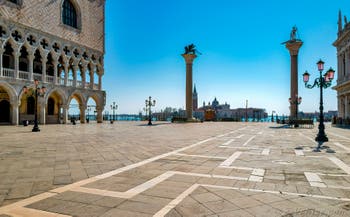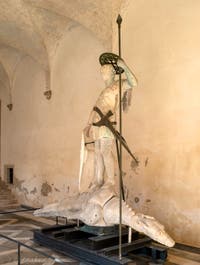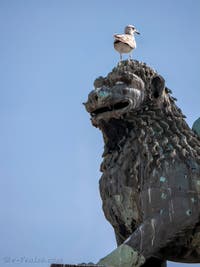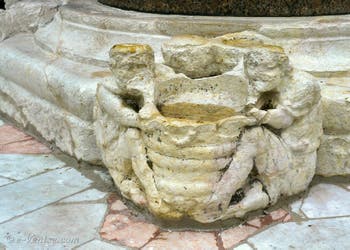Squares Arsenal | Hunchback | Dogana | Colleoni | Rioba | Piazzetta St. Mark | Stefano | Rialto Vecchio
The Piazzetta Columns - St. Mark and St. Theodore
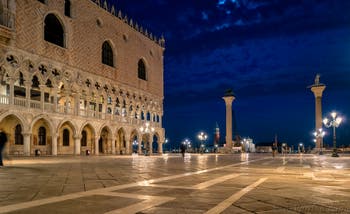
Doge's Palace and Piazzetta San Marco In 1127, Doge Domenico Michiel brought back from Caesarea the two monolithic granite columns that today adorn the Piazzetta of St. Mark.
These two columns were actually three, but one of them fell into St. Mark's basin as it was being transferred to the quay and was never recovered.
For around fifty years, the two columns lay along the old Pietro Tribuno wall, now destroyed. It was not until 1172 that they were finally erected in their current location.
The columns on the Piazzetta of St. Mark are clearly a reminder of the gigantic bronze pillars erected for Solomon by Hiram of Tyre, and we know that the Doge's Palace itself reproduces the architectural principles of King Solomon's Palace.
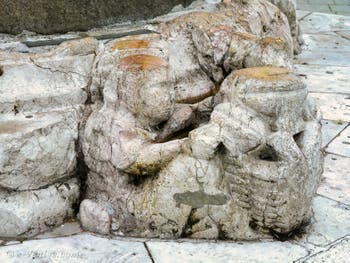
Sculptures at the feet of the columns In 1172 therefore, a Lombard architect by the name of Nicolo Lombardo presented himself to the Doge Sebastiano Ziani indicating that he had a technical solution for erecting the two columns.
The technique he employed was quite ingenious as he had sufficiently strong ropes attached to the end of each column, and then had the ropes wet.
The immediate result was that the ropes shrank and the column rose at the same time.
All that had to be done then was to place props under the part of the column already in the air and repeat the operation, and so on until the column was straight.
Silver play between the columns
Doge Sebastiano Ziani was very interested in Lombardo's proposal and so gave him the go-ahead.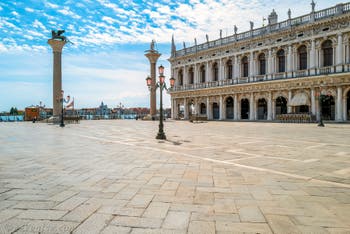
The columns of the Piazzetta San Marco But when he asked him what the price for his work would be, Nicolo Lombardo told him that all he wanted was a perpetual concession to carry on gambling in the space between the two columns.
At the time, gambling was banned in Venice, and Lombardo's request was a major departure from the rule.
Nevertheless, Doge Sebastiano Ziani, no doubt overjoyed at the prospect of seeing these two monolithic granite columns rise up from the Piazzetta, gave the architect his approval.
It was because of this haggling that Nicolo Lombardo became Nicolo Barattieri, baratto meaning “barter” in Venetian.
What Doge Ziani had not assumed was that, as well as being a good architect, Nicolo Barattieri was also a very good businessman.

The Dragon of the statue of Saint Theodore And its concession was particularly flourishing and was then passed down from generation to generation for several centuries.
Many Venetians were ruined in the games of chance that took place between the two columns and the Senate one day had enough of seeing this “immorality” happening in addition right next to the Doge's Palace, a real affront!
However, the Republic of Venice was very respectful of the law and of its word, so there could be no question of withdrawing the concession.
One senator came up with a rather sinister idea to put an end to the situation.
At the senator's suggestion, the Republic of Venice decided that from then on public executions would take place between the two columns of the Piazzetta of St. Mark.
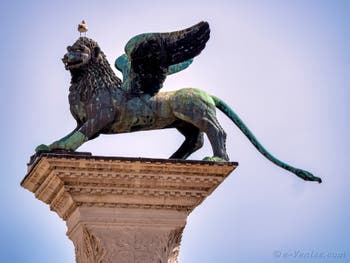
Lion of St. Mark You can imagine the effect of this decision on players, forced to play on a site that has become so bloody!
And this sinister side of the place will long permeate the minds of Venetians, as you can read in several of the quotes we present below.
The only difficulty was that the only executions allowed between the columns were those of the nobles. The only difficulty was that the only executions allowed between the columns were those of the nobles, so one day, as a result of greater tolerance of the laws or better conduct on the part of the nobles, there were no longer enough executions to effectively discourage gamblers.
The Senate, decidedly full of ideas, proposed hanging the week's hanged men here... and there were enough of them to make the place permanently sinister. Imagine playing cards under a hanged man!
It was Andrea Gritti, Doge from 1523 to 1538, who dared to ban gambling between the two columns of the Piazzetta and thus challenge the word of the Serenissima.
Even so, the concession lasted just over four centuries!
Proof that the word given to Venice was something of great value at the time.
Saint Theodore or Saint George, a Saint “composite”!
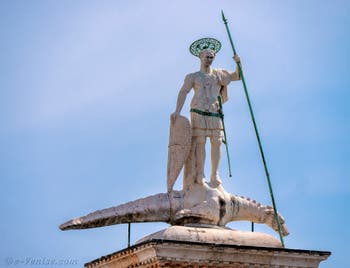
Statue of Saint Theodore On the left-hand column, the pink granite one, is a statue officially depicting Saint Theodore, his feet on a dragon for some, on a crocodile for others.
This statue was erected at the top of its column in 1329 but its composition is most surprising and holds a puzzle!
This statue of Saint Theodore piercing a dragon is in fact a statue of Saint George that the Venetians had brought back from Greece.
However, some experts believe that although it is Greek, the statue is representative of Roman art from Hadrian's time, in the first century AD.
The head of Saint Theodore is also different from the rest of the statue, which was originally a Saint George.

Statue of Saint Theodore This head is thought to have come from the Greek island of Paros and may have been that of Mithridates, King of Pontus (or The Bridge), an ancient region in northern Asia Minor on the Black Sea.
In addition, the statue, apart from the head, was not completely complete and other “pieces” which are in the style of Lombard sculpture from the first half of the XVth century would have been added.
In short, our Saint Theodore has all the makings of Saint George but that's okay since it's just a matter of faith!
Don't look for the mistake in our photographs, the statue you see there is indeed whole, as it is a copy of the original which is kept in the Doge's Palace, protected from the elements.
The Lion of Saint Mark is not Venetian but Chinese
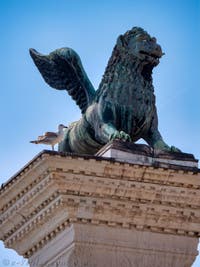
Lion of St. Mark If Saint Theodore or Saint George is already an enigma, it's almost the same for the Lion of Saint Mark perched at the top of the second grey granite column, the one on the side of the Doge's Palace.
In any case, this is a Saint Lion who is not very polite to Saint Theodore, since he turns his back on him completely.
Was there a conflict between the two patron saints of Venice?
It is thought that it was originally not a lion but a chimera.
The animal is made of bronze and dates from the 4th or 6th century.
It was long thought to be Etruscan or Persian in origin from the Sassanid period, but the latest studies carried out in 2024 now indicate that its origin is Chinese.
Other experts believe it to be a chemical of Chinese origin to which a pair of wings were later added so that it could symbolise the Winged Lion of Saint Mark.
The latest studies by researchers Massimo Vidale and Gilberto Artioli from the University of Padua, indicate that the lead in the statue comes from China and more precisely from the lower basin of the Yangtze River, the Blue River.
Comparative analyses have also been carried out and have shown thatthe Venetian lion style is similar to funerary statues from the Tang dynasty (619-907), which were used to ward off evil spirits; these lions were a kind of temple guardians.
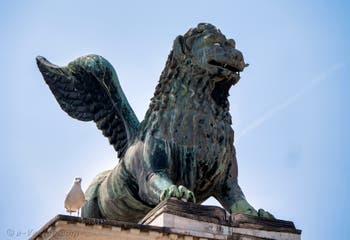
Lion of St. Mark What is certain is that, like the patron saint on the other column, this statue also had to be “tinkered with” using elements of different origins to give it its final form.
This would explain why the book, which is usually shown “standing” and in front of the lion, with its paw resting on the top of the book, is here shown “underneath” with the lion's claws firmly embedded in the book.
This bronze winged lion flew all the way to Paris in 1797, when Napoléon Bonaparte plundered the artistic treasures of Venice following its military occupation.
It was not until 1815 that the lion regained its place on its column, and we also know that it lost its book en route, probably stolen in Paris.
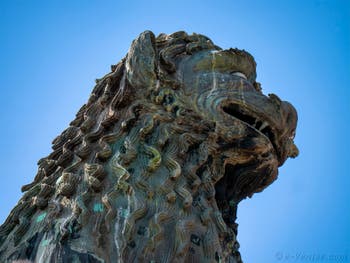
Lion of St. Mark The lion remained with his paw in the air for a few years before a new book was made for him to sink his claws into.
Finally, according to Louise Colet quoted below, our lion also lost his eyes! But we have not found confirmation of this fact in the various documents we used to write this article.
“The two huge columns carrying in the air the statue of St. Theodore and the winged lion of St. Mark.
Formerly two large diamonds formed its eyes it supported between its claws the golden gospels where the gems glittered.
The eye sockets remained empty and tawny a book of stone replaced the dazzling book; unknown despoilers possess the remains of the dethroned lion.”
Louise Colet - The Italy of Italians 1862
The two monsters do not seem to want to spawn together
“In the foreground, opposite the gondola landing, between the Library and the Ducal Palace, stand two enormous one-piece columns of African granite, once pink, but washed in cooler tones by rain and time.
The Doge's Palace and Piazzetta San Marco On the left, coming from the sea, stands a triumphant Saint Theodore, wearing a metal nimbus on his forehead, a sword at his side, a spear in his fist and his hand resting on his targe.
The two monsters do not seem to want to spawn together.
It is said that it is not a good omen to disembark between these two columns, where executions used to be carried out, and we begged the gondolier, when he put us ashore, to disembark by the stairs of the Zecca or the Pont de la Paille, not caring in the least about ending up like Marino Faliero, who was ill-fated to have been thrown by the storm at the foot of these fearsome pillars.”
Théophile Gautier - Italia 1855
There was beheaded the brave and unfortunate Carmagnola
Statue of Saint Theodore “Then, in the foreground of this square, about thirty paces apart, two granite columns transported in 1125 from the Greek archipelago to Venice by Doge Michieli, and erected where we see them in 1170, after a base had been prepared for them and bronze capitals adopted.
On the right-hand side, the statue of Saint Theodore, the first patron saint of the Republic, stands on a crocodile.
The one on the left is surmounted by the winged Lion of St. Mark, holding the open Gospel on which his claw rests.
The Place des Invalides in Paris once had this lion, taken by Bonaparte from Venice at a time when the whole of Europe was sending its artistic treasures to our capital and its museums.
But 1815 returned it to Venice.
However, he no longer possessed his Gospel, which had been taken from him by a profane hand.
It was between these two columns that the Council of Ten had those of its criminals executed whom it did not kill in the secrecy of its wells.
This is where the brave and unfortunate Carmagnola was beheaded this is where, in days gone by, the guilty and many of the innocent were struck down by the hands of the executioners.
It was to these columns that the same council, so shady and so terrible, had the corpses of all those tortured for crimes or so-called crimes of state tied by the feet.”
Alfred Driou - Travel Venice 1861
The spread wings and the elongated claw
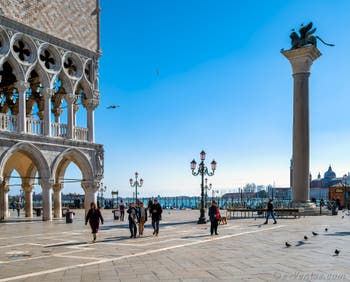
Doge's Palace and Piazzetta San Marco
“It is on a fine summer's night that the traveller who knows how to spare his impressions should see Venice for the first time.
Suppose he arrives from the Adriatic, and lands on the Piazzetta, that vestibule of St. Mark's Square which stretches from the Grand Canal to the Basilica.
He will set foot on the marble steps, between two monoliths of African granite, one of which bears above its capital the lion of St. Mark, wings spread and claw extended over the book of the Gospels; the other, a superb St. Theodore, wearing a metal nimbus, sword at his side, spear in his fist.”
Louis Énault - The Mediterranean, its islands and shores 1863
Guardati d'all' inter colonne! Beware of the intercolumn!
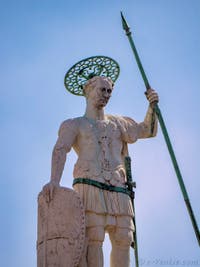
Statue of Saint Theodore
“The people of Venice always regarded the space between these two columns as harmful, and it was almost accepted as a proverb to threaten those whom one did not like, and whom a denunciation could lose, by saying to them: Guardati d'all' inter colonne! (Beware of the inter-column!)
In 1329, a marble statue of Saint Theodore, with a crocodile as its pedestal, was placed on one of these columns, the pink granite one.
St. Theodore was the Republic's first patron saint until the body of St. Mark was transferred from Alexandria to Venice, leading to what might, without irreverence, be called the removal of the first patron saint.
In fact, this lion is a much nobler and more majestic symbol for the arms of Venice than the crocodile would have been, good for making Egyptians, ibis worshippers and all those peoples of the Nile who choose their gods from the vegetable garden.
Lion of St. Mark The lion, it must be admitted, has a great deal to do with the poetry of the warlike and artistic history of Venice, and this poetry would certainly have been greatly compromised if, instead of the body of St. Mark, whose friend a lion was, Venetian merchants had found that of St. Anthony in Alexandria...
The other column, whose granite is grey, serves as a pedestal for the emblem of this fourteen-century-old Republic, the winged lion whose bronze eyes have seen so many victorious fleets return to the lagoons.
And so these two granite columns, one supporting the old, the other the new patron saint of the Republic, only, let it be said, to better watch on the high seas what is happening there, the lion has taken a very disdainful position for the saint!
This lion stayed in Paris from 1797 to 1815, and although our opinions are independent, even when they force us to turn the tip of our pen against our own nationality, we will not hesitate to say, as we have already done elsewhere in all frankness, that the removal of the lion of St. Mark from Venice by our armies was a reprehensible act unworthy of a great nation.
Sculptures at the foot of the columns It was more than just a clumsy move on the part of this fledgling Republic to take away its symbol, its national emblem, from this glorious Republic fourteen centuries old!
There is no excuse for this despoilment, for this lion is quite insignificant from an artistic point of view, and its material could not tempt the greed of the looters.
In a pinch, it would have been all right to take from Venice the Greek horses it had taken itself!
The conquering city suffered the penalty of retaliation.
But the emblem of St. Mark should never have come down from the column from which, for more than five hundred years, it had gazed out over the blue waves of the Adriatic, only to be lost on the esplanade of the Invalides, where its old republican mane must often have bristled, when the consular festivities and imperial clamour resounded around it! [...]
Lion of St. Mark During this unfortunate and humiliating stay in Paris, the noble animal lost the open Gospel on which one of its claws was resting.
Some boilermaker in the suburbs will have melted down some sacrilegious utensil!
Two years after its return to the high pedestal it should never have left, a new Gospel with bronze leaves was returned to it, and it once again rested on the pax tibi, its paw long in the air.
It has been repeated that this lion was not the same as the one that desecrating hands brought to Paris, and that this one, broken by accident at the time it was to be returned, had been replaced by a new bronze.
This version, accepted too lightly no doubt, is completely unfounded.
It must seem all the more absurd because a solid bronze monster does not break like an earthenware dog.”
Jules Lecomte - Venice 1844
Squares Arsenal | Hunchback | Dogana | Colleoni | Rioba | Piazzetta St. Mark | Stefano | Rialto Vecchio
Back to Top of Page


